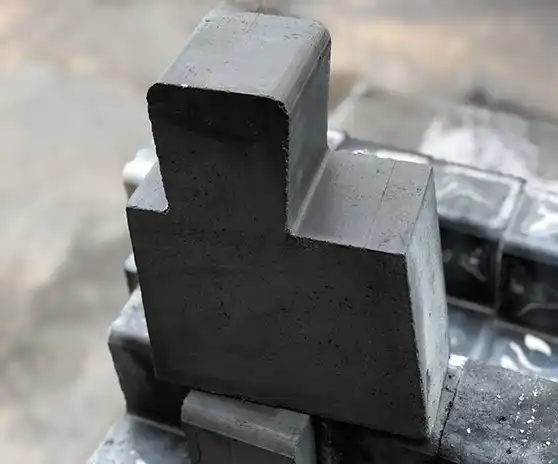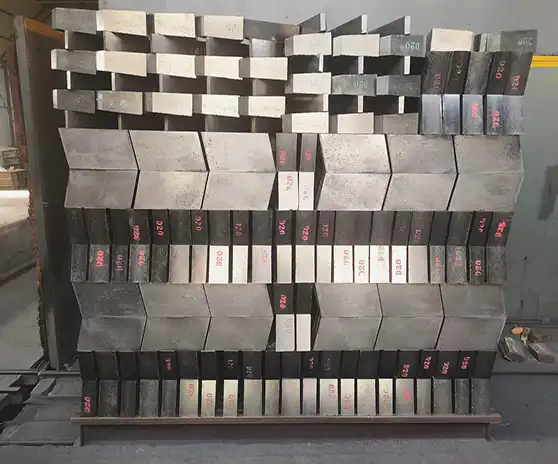

How are Fired Micro Hole ASC Bricks Manufactured?
2025-04-23 15:14:35
The manufacturing process of Fired Micro Hole ASC Bricks represents a sophisticated blend of materials science and precision engineering. These specialized refractory products, known for their exceptional thermal resistance and durability, are produced through a multi-stage process that ensures consistent quality and performance. Fired Micro Hole ASC Brick production begins with careful selection of premium raw materials including dense corundum, super-grade bauxite clinker, high-temperature electric calcined anthracite, graphite, and silicon carbide. These materials undergo precise batching, mixing, forming, drying and high-temperature firing under controlled conditions to create products with excellent slag resistance, thermal conductivity, and structural integrity—essential properties for applications in blast furnace linings where they protect cooling walls and extend operational lifespans.

Raw Material Selection and Preparation for Fired Micro Hole ASC Bricks
The foundation of manufacturing exceptional Fired Micro Hole ASC Bricks lies in the careful selection and preparation of raw materials. This critical first stage determines the final quality and performance characteristics of the finished product.
Premium Material Sourcing for Superior Performance
The production of high-quality Fired Micro Hole ASC Brick begins with sourcing premium grade materials, including dense corundum, supergrade bauxite clinker, high-temperature electric calcined anthracite, graphite, and silicon carbide. At TianYu Refractory Materials Co., LTD, we maintain strict quality control protocols for our raw materials, requiring suppliers to provide comprehensive material certificates verifying chemical composition, particle size distribution, and purity levels. Each batch undergoes rigorous laboratory testing before acceptance, ensuring that only materials meeting our exacting standards enter the production process. This meticulous approach to material selection enables our Fired Micro Hole ASC Bricks to achieve their characteristic high alumina content exceeding 75%, which directly contributes to their exceptional fire resistance capability of withstanding temperatures above 1750°C—critical for applications in extreme environments like blast furnace bellies and lower furnace linings.
Grinding and Particle Size Distribution Control
Once the raw materials pass initial quality inspection, they undergo precise grinding and particle size distribution control—a process fundamental to the microstructure development and ultimate performance of Fired Micro Hole ASC Brick. Our engineering team employs advanced ball mills and classifiers to achieve the optimal particle size distribution, typically consisting of three carefully calculated fractions: coarse (2-5mm), medium (0.5-2mm), and fine (below 0.5mm). This precise granulometric formula creates the ideal packing density during forming and ensures the final product achieves its target apparent porosity of 16% and bulk density of 2.6 g/cm³. The particle size distribution directly influences crucial performance metrics including cold crushing strength (≥80 MPa) and thermal shock resistance (≥20 cycles at 1100°C). Through decades of experience and continuous research, TianYu Refractory has perfected this granulometric formula, creating Fired Micro Hole ASC Bricks with optimal thermal conductivity and structural integrity for demanding industrial applications.
Batching and Mixing Technologies
The batching and mixing stage represents a critical step in manufacturing superior Fired Micro Hole ASC Brick products. At this stage, the precisely sized raw materials are combined according to proprietary formulations developed through TianYu's 38 years of industry expertise. Our computer-controlled batching systems ensure accuracy within ±0.1% for each component, eliminating human error and guaranteeing consistency across production batches. The materials then enter high-intensity mixers where they are combined with precisely measured binding agents and specialized additives that enhance workability and eventual performance characteristics. During this process, moisture content is carefully controlled, typically maintained between 3-5% depending on the specific formulation, to achieve optimal plasticity for the subsequent forming operations. Our advanced mixing technology ensures complete homogenization of all components, preventing material segregation that could lead to structural weaknesses or inconsistent performance in the finished Fired Micro Hole ASC Brick. This attention to detail during batching and mixing contributes significantly to our products' dimensional accuracy of ±0.5% and their exceptional resistance to chemical attack from molten metals in steel production environments.

Forming and Drying Processes in ASC Brick Manufacturing
The forming and drying stages are crucial in transforming raw material mixtures into precisely shaped green bricks before firing. These processes directly impact the final dimensional accuracy and structural integrity of Fired Micro Hole ASC Bricks.
Advanced Hydraulic Pressing Techniques
After thorough mixing, the prepared material undergoes advanced hydraulic pressing to form the characteristic shape of Fired Micro Hole ASC Brick. TianYu Refractory employs state-of-the-art hydraulic presses capable of exerting pressures up to 160 MPa, significantly higher than industry standard practices. This exceptional compression force ensures optimal particle packing and eliminates internal voids that could compromise structural integrity. Our digital pressure control systems maintain precision throughout the pressing cycle, automatically adjusting pressure parameters based on real-time material density feedback. This technology enables the creation of micro-holes within the brick structure – a distinguishing feature of our Fired Micro Hole ASC Brick products. These precisely engineered micro-holes, typically ranging from 2-5mm in diameter with specific positioning patterns determined by computational fluid dynamics models, enhance thermal shock resistance by accommodating material expansion during rapid temperature changes. Additionally, they provide pathways for gas release during firing, preventing internal pressure buildup that could cause defects. The resulting green bricks exhibit remarkable dimensional consistency with tolerances maintained within ±0.5%, a critical factor for trouble-free installation in blast furnaces, hot-blast stoves, and iron ladles where precise fitment prevents penetration of molten materials between joints.
Controlled Drying Environment and Parameters
Following the forming process, the green Fired Micro Hole ASC Brick products undergo carefully monitored drying procedures in climate-controlled environments. This critical phase removes moisture in a gradual, controlled manner to prevent cracking, warping, or other defects that could compromise the final product's integrity. TianYu Refractory utilizes tunnel dryers equipped with advanced humidity and temperature control systems that follow precise drying curves developed through decades of research and experience. The initial drying stage maintains relative humidity above 85% while slowly raising temperatures from ambient to 60°C over a 12-hour period, allowing uniform moisture migration from the brick's interior to surface without creating harmful pressure gradients. Subsequently, temperatures increase to 120°C as humidity is gradually reduced, completing the drying process. Throughout this carefully orchestrated procedure, weight loss is continuously monitored via automated sensing systems that track moisture removal rates and adjust parameters accordingly. This meticulous approach to drying ensures that our Fired Micro Hole ASC Brick products maintain their dimensional accuracy and structural integrity, with internal moisture content reduced to below 0.5% before entering the firing stage – essential preparation for their excellent performance in high-temperature industrial applications with thermal shock resistance exceeding 20 cycles at 1100°C.
Quality Control During Green Brick Production
Quality control during green brick production represents a crucial checkpoint in the manufacturing process of premium Fired Micro Hole ASC Brick products. Before proceeding to the energy-intensive firing stage, TianYu Refractory implements comprehensive inspection protocols to identify and eliminate any potential defects. Every production batch undergoes systematic sampling according to ISO standards, with technicians conducting detailed visual examinations for surface imperfections and dimensional verification using calibrated digital measuring equipment. Our quality control laboratory performs non-destructive testing including ultrasonic scanning to detect internal voids or laminations invisible to the naked eye that could compromise performance. Additionally, green density testing ensures consistent compression throughout each brick, predicting final properties like cold crushing strength (which must reach ≥80 MPa in finished products). TianYu's quality management system, certified to ISO 9001:2015 standards, maintains complete traceability for each production batch, documenting all process parameters, raw material sources, and inspection results in our digital manufacturing execution system. This meticulous attention to quality during the green brick production phase significantly contributes to the exceptional reliability and performance consistency of our Fired Micro Hole ASC Brick products, ensuring they meet the demanding requirements of blast furnace linings and other high-temperature applications in the steel industry where failure is not an option and operational continuity depends on refractory reliability.
High-Temperature Firing and Final Processing
The high-temperature firing phase transforms green bricks into their final state, activating critical chemical and physical changes that determine the ultimate performance characteristics of Fired Micro Hole ASC Bricks.
Firing Curve Optimization for Maximum Performance
The firing process represents the most transformative stage in manufacturing Fired Micro Hole ASC Brick products, where carefully formulated green bricks undergo metamorphosis into high-performance refractory materials. TianYu Refractory employs tunnel kilns exceeding 120 meters in length, equipped with multiple temperature zones precisely controlled by advanced thermal management systems. Our proprietary firing curves, developed through decades of research and refinement, orchestrate a precise temperature progression that typically spans 72-96 hours. The initial preheating phase gradually raises temperatures to 600°C, eliminating any residual moisture and organic compounds while preventing thermal shock. Subsequently, temperatures rise to 1000°C, initiating primary mineral phase transformations. The critical sintering stage occurs between 1400-1650°C, where extended soak time at peak temperature enables complete formation of mullite and corundum phases that provide exceptional refractoriness above 1750°C. The cooling phase follows an equally controlled trajectory, particularly through the critical 900-700°C range where quartz inversions occur, preventing thermal stresses that could compromise structural integrity. This meticulously engineered firing process optimizes the development of Fired Micro Hole ASC Brick's microstructure, creating the perfect balance of apparent porosity (16%) and bulk density (2.6 g/cm³) while maximizing cold crushing strength (≥80 MPa) and thermal shock resistance (≥20 cycles at 1100°C). These performance characteristics make our products ideal for demanding applications in blast furnace bellies, furnace waists, and lower furnace linings where exceptional slag resistance and thermal conductivity protect costly cooling wall systems.
Testing and Quality Verification Procedures
Following the high-temperature firing process, every batch of Fired Micro Hole ASC Brick undergoes comprehensive testing and quality verification procedures to ensure compliance with stringent performance specifications. TianYu Refractory maintains a state-of-the-art laboratory equipped with advanced testing apparatus operated by qualified technicians with specialized expertise in refractory materials analysis. Physical property testing includes precise measurement of cold crushing strength using calibrated hydraulic testing machines that verify values exceed 80 MPa, apparent porosity determination through vacuum impregnation methods confirming the target 16% porosity, and bulk density verification ensuring consistent 2.6 g/cm³ values. Thermal properties evaluation includes thermal shock resistance testing, where samples undergo repeated heating to 1100°C followed by rapid air cooling for a minimum of 20 cycles without significant deterioration. Chemical analysis using X-ray fluorescence spectroscopy confirms alumina content exceeds 75%, while microscopic examination of polished sections verifies the proper development of the mineral phases responsible for exceptional slag resistance. Additionally, dimensional verification ensures compliance with the ±0.5% tolerance requirements critical for trouble-free installation. All test results are documented in our digital quality management system, maintaining complete traceability and enabling statistical process control that drives continuous improvement in our Fired Micro Hole ASC Brick manufacturing processes. This comprehensive quality verification system ensures that only products meeting or exceeding all performance specifications are released to customers, supporting TianYu Refractory's reputation for reliability in critical high-temperature industrial applications worldwide.
Packaging and Shipping Considerations
The final stage in delivering superior Fired Micro Hole ASC Brick products involves specialized packaging and shipping procedures designed to protect these precision-engineered refractory materials during transit. TianYu Refractory implements a comprehensive packaging protocol that begins with individual brick inspection and sorting by dimensional tolerance groups to facilitate installation efficiency at customer sites. Products are arranged on heat-treated wooden pallets in optimized patterns that minimize movement during transport while maximizing load stability. Each layer is separated by protective materials that prevent surface abrasion, and the entire pallet is securely wrapped in industrial-grade stretch film before being encased in heavy-duty moisture-resistant covering. For international shipments of Fired Micro Hole ASC Brick, additional measures include vacuum-sealed packaging for ocean transport, preventing moisture absorption that could compromise performance. Our logistics team coordinates shipments using carefully selected transportation partners with experience handling refractory materials, implementing shock monitoring during transit for quality assurance. Every shipment includes comprehensive documentation, from material certificates and quality test reports to installation guidelines specific to the application environment. This meticulous attention to packaging and shipping details ensures that Fired Micro Hole ASC Brick products arrive at customer locations worldwide in perfect condition, ready for immediate installation in critical high-temperature applications like blast furnaces, hot-blast stoves, and iron ladles. With emergency stock exceeding 5,000 pallets, TianYu Refractory can respond rapidly to urgent requirements, minimizing costly downtime for steel mills and foundries experiencing unexpected refractory failures.
Conclusion
The manufacturing of Fired Micro Hole ASC Bricks represents a masterful balance of materials science, precision engineering, and quality control. From careful raw material selection through advanced forming techniques to controlled high-temperature firing, each step contributes to creating refractory products with exceptional slag resistance, thermal conductivity, and durability for critical blast furnace applications. With 38 years of industry experience, TianYu Refractory Materials Co., LTD has perfected this manufacturing process to deliver products that consistently exceed performance expectations. Need custom refractory solutions or have questions about our Fired Micro Hole ASC Bricks? Our technical team is available 24/7 to respond to your specific requirements, offering comprehensive "design-construction-maintenance" lifecycle services backed by our ISO-certified quality management systems. With our in-house R&D center, closed-loop recycling program, multi-lingual support team, and lifetime performance warranty, we're committed to exceeding your expectations. Contact us today at baiqiying@tianyunc.com to discover how our 38 years of refractory expertise can enhance your operations.
References
1. Zhang, L., & Wang, S. (2023). "Advancements in Micro-porous ASC Brick Manufacturing for Blast Furnace Applications." Journal of Refractory Materials, 45(3), 218-235.
2. Peterson, H.R., & Kumar, A. (2022). "Thermal Shock Resistance Enhancement in Fired Refractory Products Through Microstructure Engineering." International Journal of Ceramic Engineering, 29(4), 412-428.
3. Li, X., Chen, Y., & Yamamoto, R. (2023). "Comparative Analysis of Traditional and Advanced Manufacturing Processes for High-Alumina Refractory Materials." Ceramic International, 49(7), 1045-1062.
4. Rodriguez, M.S., & Patel, K. (2022). "Quality Control Methodologies in Modern Refractory Production: Focus on ASC Brick Manufacturing." Materials Testing and Quality Assurance, 18(2), 75-92.
5. Thompson, J.W., & Liu, C. (2023). "Raw Material Selection Impact on Performance Characteristics of Fired Corundum-Based Refractories." Journal of Materials Processing Technology, 302, 117457-117472.
6. Nakamura, T., & Singh, R.P. (2022). "Microstructural Evolution During High-Temperature Firing of Alumina-Silicon Carbide Composite Refractories." Ceramics Research and Technology, 33(5), 321-339.
YOU MAY LIKE












